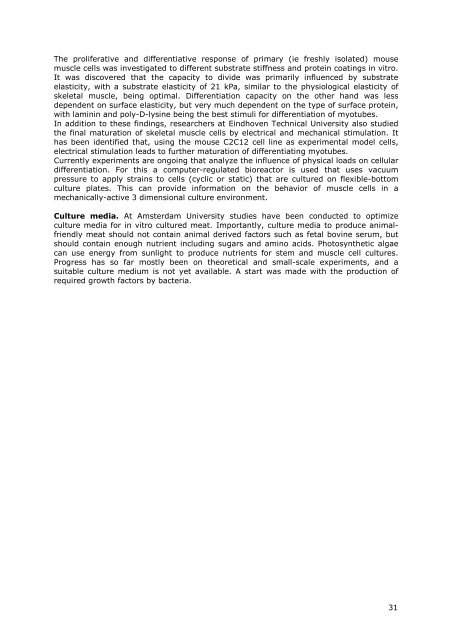production of animal proteins by cell systems - New Harvest
production of animal proteins by cell systems - New Harvest
production of animal proteins by cell systems - New Harvest
Create successful ePaper yourself
Turn your PDF publications into a flip-book with our unique Google optimized e-Paper software.
The proliferative and differentiative response <strong>of</strong> primary (ie freshly isolated) mouse<br />
muscle <strong>cell</strong>s was investigated to different substrate stiffness and protein coatings in vitro.<br />
It was discovered that the capacity to divide was primarily influenced <strong>by</strong> substrate<br />
elasticity, with a substrate elasticity <strong>of</strong> 21 kPa, similar to the physiological elasticity <strong>of</strong><br />
skeletal muscle, being optimal. Differentiation capacity on the other hand was less<br />
dependent on surface elasticity, but very much dependent on the type <strong>of</strong> surface protein,<br />
with laminin and poly-D-lysine being the best stimuli for differentiation <strong>of</strong> myotubes.<br />
In addition to these findings, researchers at Eindhoven Technical University also studied<br />
the final maturation <strong>of</strong> skeletal muscle <strong>cell</strong>s <strong>by</strong> electrical and mechanical stimulation. It<br />
has been identified that, using the mouse C2C12 <strong>cell</strong> line as experimental model <strong>cell</strong>s,<br />
electrical stimulation leads to further maturation <strong>of</strong> differentiating myotubes.<br />
Currently experiments are ongoing that analyze the influence <strong>of</strong> physical loads on <strong>cell</strong>ular<br />
differentiation. For this a computer-regulated bioreactor is used that uses vacuum<br />
pressure to apply strains to <strong>cell</strong>s (cyclic or static) that are cultured on flexible-bottom<br />
culture plates. This can provide information on the behavior <strong>of</strong> muscle <strong>cell</strong>s in a<br />
mechanically-active 3 dimensional culture environment.<br />
Culture media. At Amsterdam University studies have been conducted to optimize<br />
culture media for in vitro cultured meat. Importantly, culture media to produce <strong>animal</strong>friendly<br />
meat should not contain <strong>animal</strong> derived factors such as fetal bovine serum, but<br />
should contain enough nutrient including sugars and amino acids. Photosynthetic algae<br />
can use energy from sunlight to produce nutrients for stem and muscle <strong>cell</strong> cultures.<br />
Progress has so far mostly been on theoretical and small-scale experiments, and a<br />
suitable culture medium is not yet available. A start was made with the <strong>production</strong> <strong>of</strong><br />
required growth factors <strong>by</strong> bacteria.<br />
31



